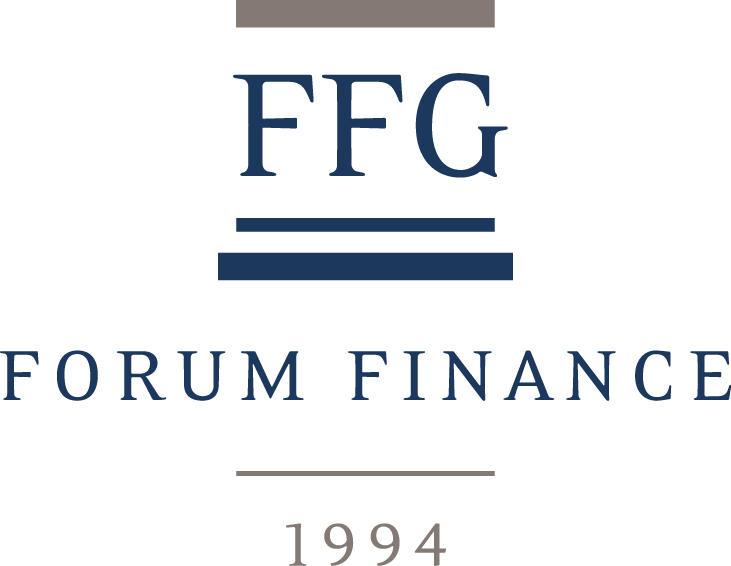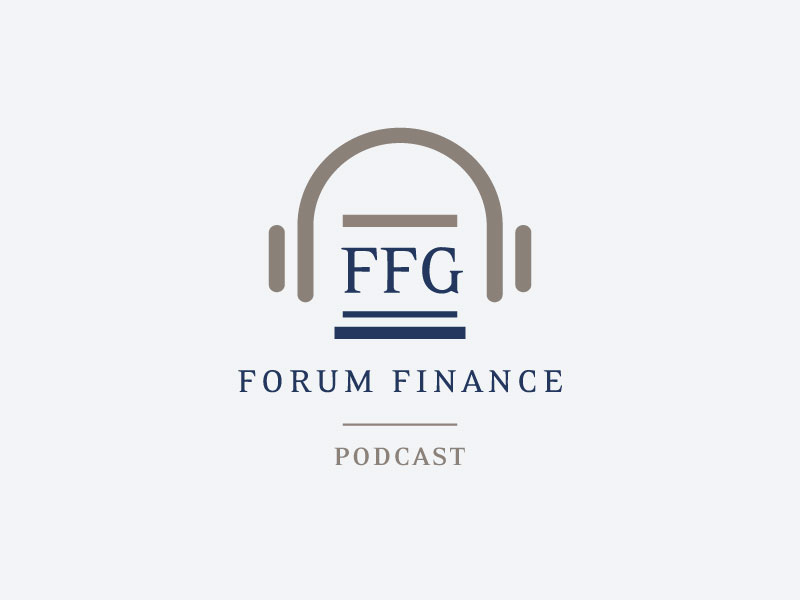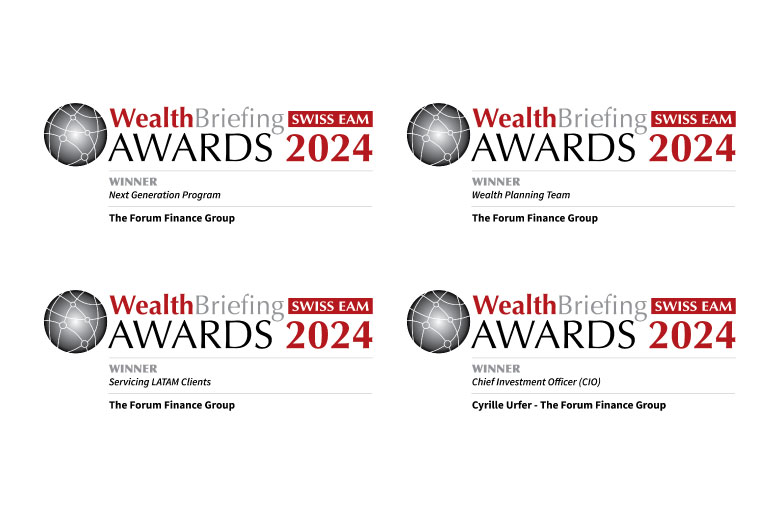Outlook | 2H 2024
1 July 2024Financial News,Investment perspectives
Executive summary
We favour a more balanced positioning across and within asset classes. We believe that bond yields, including those on government bonds - something new for this segment - are attractive. Credit carry is attractive relative to corporate fundamentals, while long-dated government bonds offer protection in more difficult times in addition to their real yield.
Favourable economic data and the prospect of interest rate cuts, i.e. the ingredients of the soft-landing narrative, together with solid quarterly earnings, justify a constructive stance on equity markets. However, we would like to see a broader participation in the market rally to reduce the fragility of the bull cycle that started in early 2023.
While maintaining an allocation to the technology sector and the famous seven giants, we are balancing our portfolios with exposure to small/mid-caps and the value style, where valuations appear to offer significant catch-up potential.
Economic Outlook
Real GDP forecasts lowered for the US and Japan. China and euro area upgraded
Monetary easing becomes more widespread
Fed and Bank of England will remain on hold until September and August, respectively
FOMC dot plot implies only one 25 bps cut by year-end and four in 2025
Fannie Mae predicts that US mortgage rates will average 7% in 2024
Key Risks
Sharper slowdown in the US as labour market deteriorates sharply
US/China and EU/China trade war intensifies
Sovereign debt crisis forces governments to cut spending
Populist drift at the ballot box, testing the foundations of our democracies
Investment Convictions
Fixed income generally does well when the Fed pauses
Long-dated government bonds as a hedge against renewed recession fears
Inflation dynamics favour European over US rates (10-Year +)
EM corporate bonds offer wider spreads and diversification benefits
Prefer EU Fantastic Five to US Magnificent Seven
Small/Mid-Caps offer compelling valuation and economic sensitivity
Add value stocks for their relative valuation and diversification
Table of contents
- OUTLOOK 2024
- A BRIEF REVIEW : THE FIRST HALF OF 2024
- MID-YEAR OUTLOOK
- INVESTMENT CONVICTIONS : THE SECOND HALF OF 2024
- ASSET CLASS VIEWS - 2H 2024 : SHIFTING TO NEUTRAL
Download the Outlook 2H 2024
Newsletter | May 2024
4 June 2024Financial News,Newsletter
Global economic growth expanded at the fastest pace in ten months
15.65% THE PERFORMANCE OF THE SILVER PRICE
Investment perspective
April's correction seems almost forgotten thanks to May's rally, which took equity markets to new highs. But June is likely to be another volatile month, with the monetary policy decisions of the major developed central banks on the agenda. Recent economic data, particularly on the inflation front, has been broadly in line with consensus expectations, albeit with a glaring lack of progress towards the central bank's ultimate target of 2.0%. In the US, the personal consumption expenditure (PCE) price index excluding food and energy rose 0.2% in April (in line with estimates) and 2.8% year-on-year, or 0.1% above the estimate. More important, however, is the direction of core inflation. In April, core prices were up 3.6% year-on-year, down from 3.8% in March and up 0.3% month-on-month, the smallest monthly increase since December. In the UK, inflation continued to fall in April to its lowest level since July 2021, with consumer prices up 2.3% year-on-year. However, core prices, which strip out volatile food and energy prices, were up 3.9% year-on-year. Probably still too high for the Bank of England. Eurozone inflation rose 2.6% in May, higher than expected, while core inflation rose to 2.9% from 2.7% in April. Although May's figures were better than expected, it's worth remembering how far we've come since the peak of 10.6% in October 2022. May mirrored April across all fixed income segments. Bond indices were all in positive territory over the month. High yield (HY) markets and emerging market debt (EMD) more than recouped April's losses. Despite the rebound in May, the corporate investment grade (IG) segment remained in negative territory for the second quarter, with a negative return of 75 basis points for the quarter to date after a lackluster first quarter. With PMI indices in the major regions in the range generally associated with expansion (above 50) and encouraging developments in the eurozone, equity markets reached new highs in May. The US large cap segment gained 4.9%. In terms of investment style, growth outperformed value with a gain of 6.0% compared to 3.2% for value, while small caps returned over 5.0% for the month. Although European indices underperformed their US counterparts (+3.3% in euro terms), the Swiss equity market staged a comeback, rising by 6.3% in local currency terms.
Investment strategy
Recent publications have partly allayed immediate fears of an uncontrolled resurgence of inflation, allowing US long-term rates to ease slightly over the month. As a result, the ECB is widely expected to cut its key rates on June 6th, and any other decision would be a major surprise. With the economy and labour market in relatively good shape, the Fed is expected to keep rates on hold until it sees more evidence that inflation is on track to reach its 2% target. The all-in yield, as well as the hope of capital gains once the central banks start cutting rates, has made fixed income quite attractive. These factors have attracted investors, as evidenced by flows into the corporate bond market. According to the latest release from Bank of America, investment grade (IG) corporate bonds recorded their 31st positive weekly flow, with $3.6bn in the week ending last Wednesday, the longest streak since 2019. Despite the strong inflows, fixed income markets, particularly those with high interest rate sensitivity, have suffered. The ongoing inversion of the yield curve, caused by a slower decline in inflation towards the central banks' ultimate target of 2.0%, has led to greater caution regarding the speed and amplitude of policy rate cuts. This recalibration of interest rate expectations has made short-term bonds, and to some extent cash, attractive because of their favourable interest rate risk/return profile at a time when the path of interest rates is still quite uncertain.
One Stock Driving the Magnificient 7’s in 2024: NVIDIA +138% as of May 29th Close
Portfolio Activity/ News
After two months of fairly balanced returns in fixed income markets and modest gains in economically sensitive assets such as credit spreads and equities, we maintain a balanced positioning across asset classes, regions and sectors. Thanks to attractive all-in yields, our positioning remains broadly exposed to credit, which should continue to benefit from the growing acceptance that global economic growth will remain resilient and even improve in some regions. Admittedly, credit spreads have already tightened considerably in response to this favourable environment and are trading below the median spreads of the last 5, 10 and 30 years. However, while spreads reflect a lot of positive news, they have historically shown that they can remain tight for extended periods of time. Given the reduced uncertainty about the near-term path of US long-term rates, the improvement in emerging market economies and the easing of election deadlines following the results in Mexico and India, we are increasing our exposure to USD-denominated EM corporate debt. As we did a few months ago, we have added a long/short equity position within our European equity exposure to increase the resilience of this segment. In emerging markets, we maintain our conviction in Chinese domestic equities. It should be noted that our dedicated EM exposure is largely achieved through a dedicated bond component, which currently offers a more favourable risk/return profile than emerging market equities excluding China.
Download the Newsletter
After 30 years of success, Forum Finance has established itself as a leader in independent asset management in Switzerland
7 May 2024Press Releases & Sponsoring,Press Releases
After 30 years of success, Forum Finance has established itself as a leader in independent asset management in Switzerland
Geneva, 7 May 2024 – 30 years after its creation, Geneva-based asset management company The Forum Finance Group SA is reaping the rewards of its investments and is thus ready to face the decades to come. With more than 25 employees overseeing almost CHF 2 billion, Forum Finance now ranks among the top 3% of independent asset managers in Switzerland and has the resources to match its ambitions. Thanks to its proven corporate governance, which provides access to capital for new partners, it is able to attract talented individuals who share its entrepreneurial vision
The results of its first 30 years of existence are particularly positive, and Forum Finance celebrated this jubilee in style last month by winning four major awards at the WealthBriefing Swiss EAM Awards 2024 (best ‘Next Gen’ program, best wealth planning team, best service to Latin American clients and best Chief Investment Officer in the person of Cyrille Urfer).
Its size enables Forum Finance to make the investments necessary to ensure its future development, whether in terms of technology or human resources. More fundamentally, at a time when many first-generation investment companies are struggling to find buyers or to ensure the succession of their founders, Forum Finance has for years had an effective and resilient governance system in place, which allows for a smooth renewal of its shareholder base and the arrival of new partners at the helm. This is a convincing argument for private bankers looking for a new home.
Forum Finance was also able to anticipate at an early stage the changes in the asset management industry. As early as 2015, it strengthened its structures in order to obtain a CISA licence from FINMA. Forum Finance is also registered with the SEC, which allows it to deal with US clients and provides an additional guarantee of solidity and transparency. In addition, Forum Finance has been investing for years in its research, investment management and wealth advisory resources, in order to respond effectively to the changing needs of its clients. Forum Finance thus offers wealth managers with an entrepreneurial spirit a solid framework, offering a fair and collaborative culture.
Hippolyte de Weck, CEO of Forum Finance, said: “Our 30th anniversary celebrations are the culmination of two particularly positive years for Forum Finance, with the appointment of two partners in 2022, the arrival of a new partner and the strengthening of our Board of Directors last year, topped off by four awards from WealthBriefing last month. Over the past thirty years, our company has grown considerably to become one of the leading players in the Swiss market. We owe this success, of course, to the commitment of each and every one of our employees, but above all to the trust and loyalty of our customers.”
For additional information, please contact :
Egon Vorfeld
The Forum Finance Group SA
T: +41 (0)22 552 83 00
E: vorfeld@ffgg.com
ffgg.com
Ricardo Payro
Payro Communication Sàrl
T: +41 (0)22 322 13 17
E: :rp@payro.ch
payro.ch
About Forum Finance
Founded in 1994 in Geneva, Forum Finance offers private banking and asset management services to a high-end global clientele. It has 25 employees who manage and supervise around CHF 2 billion. The company is authorised under the CISA licence by FINMA and is registered with the SEC as investment adviser.

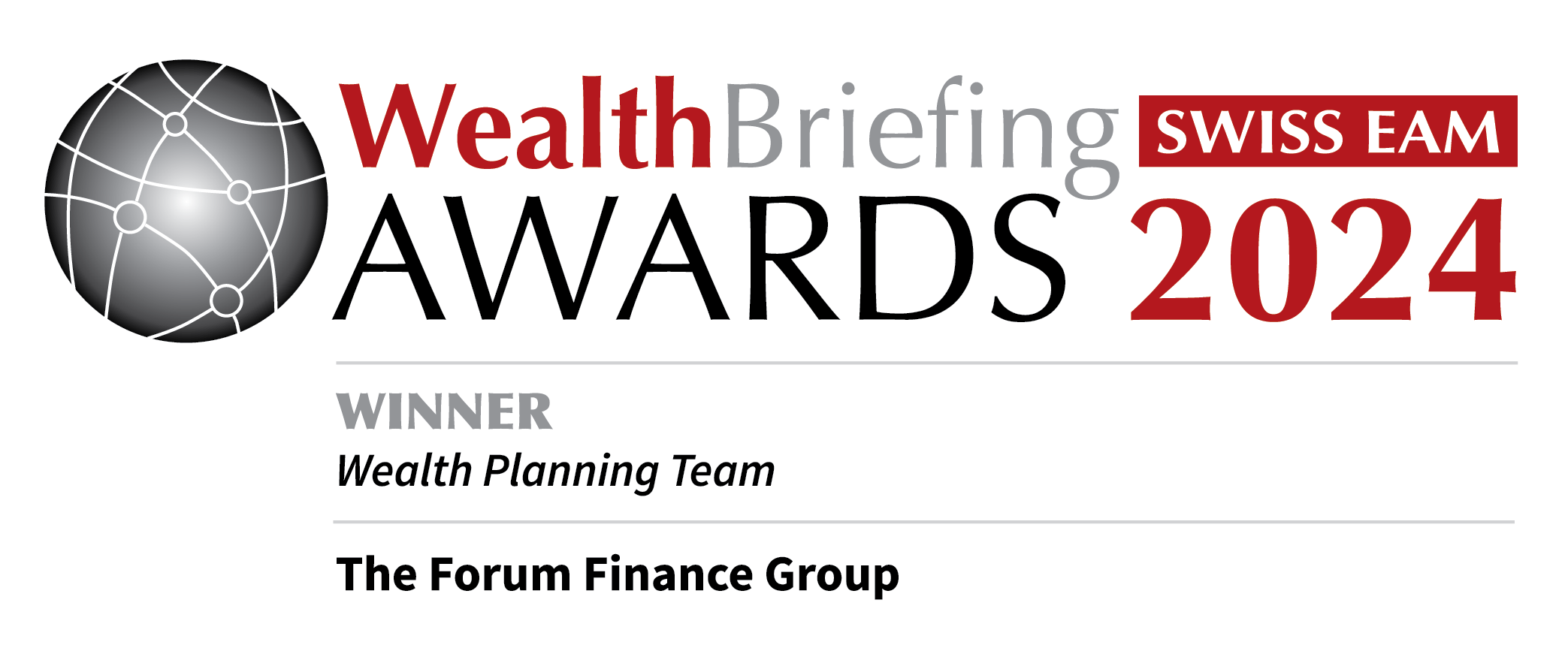
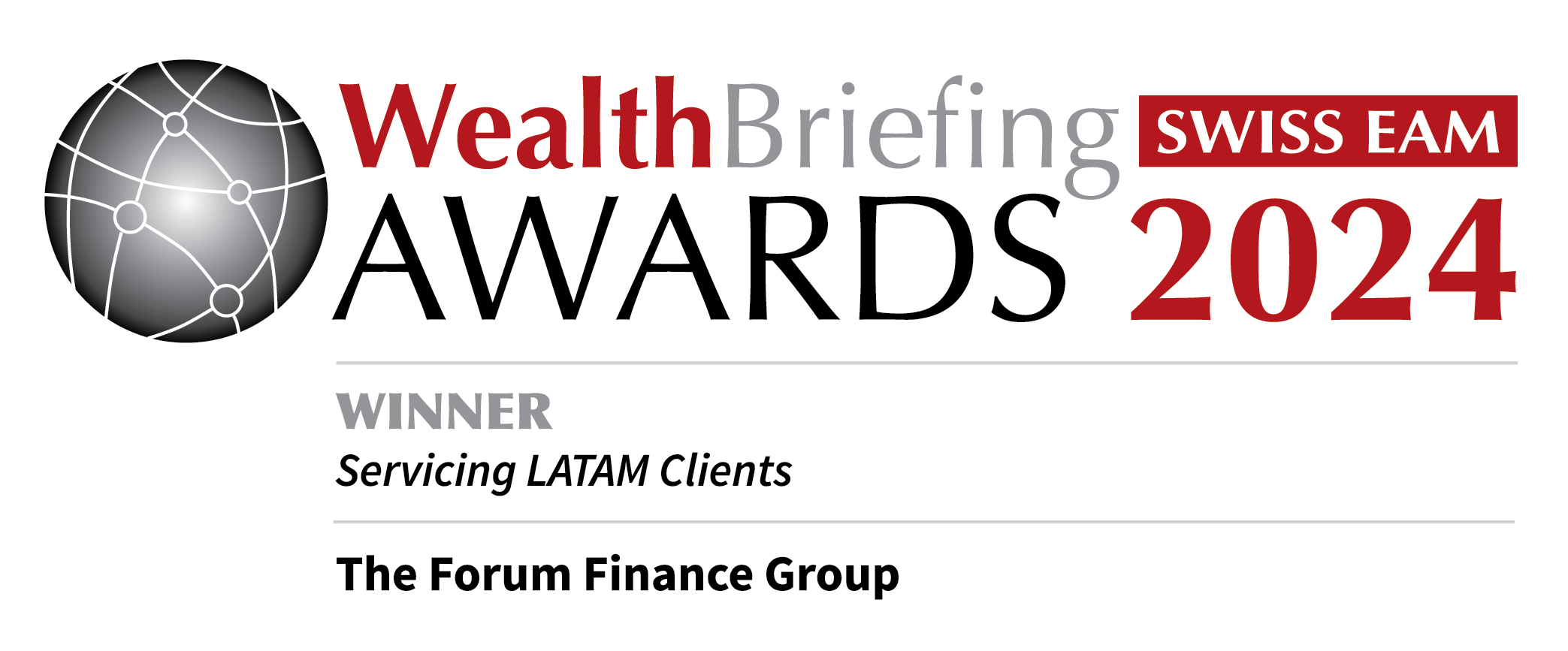
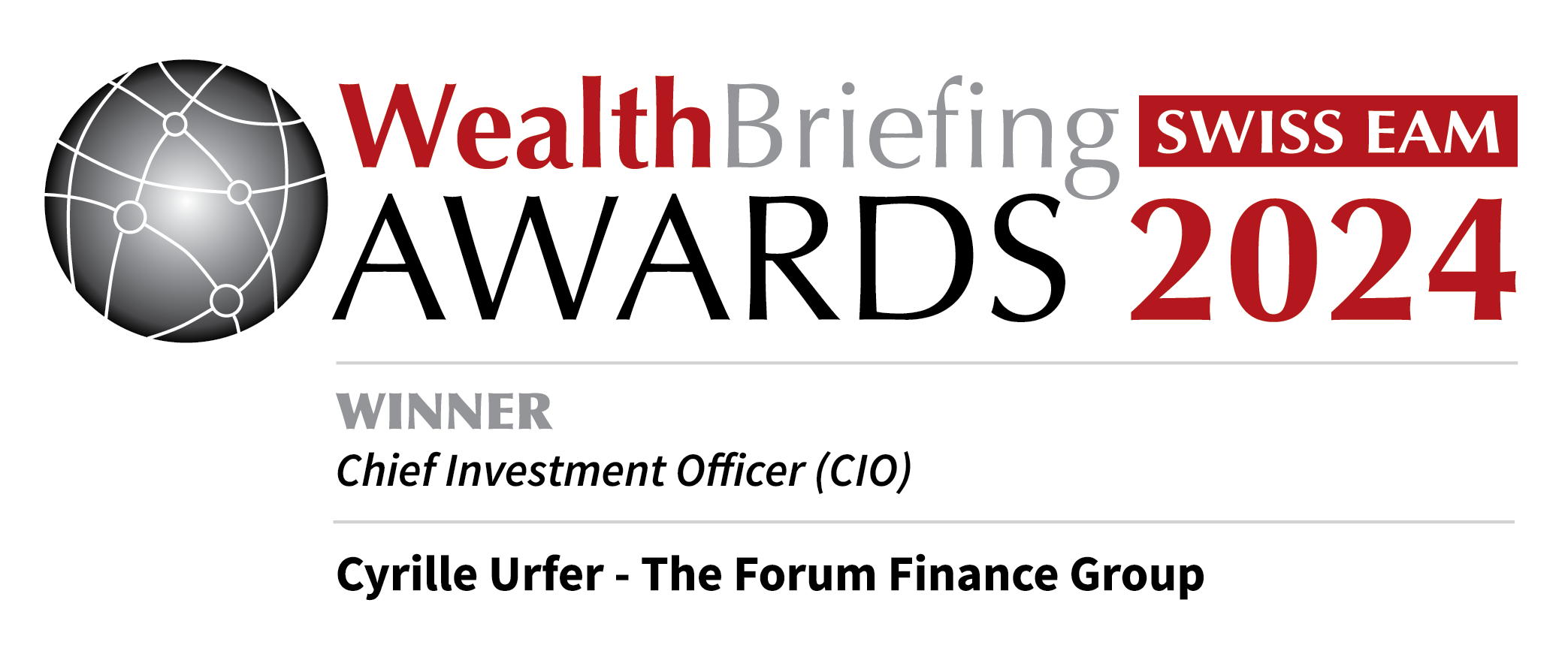
Newsletter | April 2024
6 May 2024Financial News,Newsletter
NVIDIA accounted for 41% of the year-to-date gain in the US Large Cap Index
13.91% THE PERFORMANCE OF THE COPPER PRICE
Investment perspective
The paths of the major economies are increasingly diverging. In the United States, economic activity continues to expand, ruling out a recessionary scenario induced by cumulative monetary tightening. While US growth has probably peaked, it cooled more than expected in the first quarter of the year, growing at an annualized rate of just 1.6%, down from 3.4% in the fourth quarter of last year. Disinflation began in late 2022, but the pace of decline has slowed in recent months. Weaker growth combined with stubborn inflation could take us into the realm of stagflation, a term that has horrified most central bankers, as the last comparable situation was in the 1970s following the rise in oil prices caused by the Arab oil embargo. The euro area manufacturing sector continued to contract in April, but some positive developments should be highlighted, such as factory output shrinking at the slowest rate in a year. In contrast to the US, where the disinflation process has stalled, at least temporarily, European inflation has continued to fall, with the headline rate falling to 2.4% in March. April saw negative returns across all fixed income segments as long-term rates came under pressure. The 10-year US Treasury yield rose from 4.2% to 4.7%. European yields were not immune to this trend, with the 10-year Bund ending the month 30 basis points higher at 2.6%. Recent economic data spooked investors and triggered a general downturn, except for emerging markets. US blue chip equities fell by 4.2%. The decline was even more pronounced in the small cap segment, which fell by 7.0%. European equity indices fell less than their US counterparts, with little difference in market capitalization. The main European index fell by 0.9% in euro terms. The Japanese market was not immune to the selling pressure, falling 1.1% in local currency terms, exacerbated by the accelerating depreciation of the yen of around 4% in April alone. In China, the publication of better-than-expected GDP figures provided some relief to the growth momentum of the world's second largest economy. In the short term, the Chinese market rose by 6.6%, bucking the general decline in developed equity markets. Commodities can act as performance enhancers and offer countless opportunities. After gold and silver in March, base metals such as copper and zinc took over in April. Copper rose 13.9% over the month, benefiting from China's awakening and fears of tighter supply.
Investment strategy
The divergent paths of growth and inflation will force each central bank to pursue divergent monetary policies, in contrast to what we saw during the synchronized rate hike cycle. We still expect developed central banks, led by the Europeans, to start normalizing policy rates in June. As far as the Fed is concerned, it may postpone its first cut until September, with a more gradual pace than initially expected. Higher rates make bonds quite attractive from a valuation point of view. However, we remain cautious on duration. Our central scenario remains a steepening yield curve, which favors intermediate maturities given the current flat yield curve. Credit spreads have tightened, reflecting the growing acceptance of the soft-landing scenario. US equities remain relatively vulnerable to "higher for longer" rates due to high valuations (all measures well above multi-year averages and close to the highest levels in over two years). European equities look attractive relative to the US, especially if the ECB starts cutting rates in June. Pressure on the Japanese yen could trigger either higher interest rates or currency intervention, both of which would lead to tighter financial conditions, which are not favorable for Japanese equities. The outlook for Chinese equities has brightened and offers attractive relative undervaluation.
Q1 2024: US companies report higher net profit margin quarter-on-quarter
Portfolio Activity/ News
We had highlighted the favourable seasonality of April in terms of market returns and the critical levels reached by various technical indicators. This technical configuration led us to be more cautious in our allocations than at the beginning of the year. A cautious stance was clearly rewarded during the month, whereas blindly following historical observations would have resulted in significant losses. Against this volatile backdrop, it is worth noting the positive performance of our L/S manager in US equities, which delivered positive return. To take account of the deterioration in the technical picture, particularly in US 10-year Treasury yields, we reduced our equity allocation during the month in favour of cash. We continued to make adjustments to the composition of our equity portfolio. We took profits on so-called growth stocks in the US, Europe and globally and reallocated part of the proceeds to value managers in order to achieve a better sector balance and factor exposure (value versus growth). We have not changed our bond positioning, which remains generously exposed to credit (IG and HY) and emerging markets. The sensitivity to volatility remains moderate, given the flat yield curve and the expectation that the curve will steepen. We recognise that at these yield levels, rates are competitive and offer good protection in the event of a more pronounced economic downturn. We maintain our weighting in liquid alternative strategies, which should continue to add to performance, as they have done since the beginning of the year, thanks to their exposure to commodities.
Download the Newsletter
Newsletter | March 2024
8 April 2024Financial News,Newsletter
The US Large Cap Index hit eight new closing highs in March
10.09% THE PERFORMANCE OF SILVER PRICE
Investment perspective
Despite the most aggressive tightening cycle, the US economy continues to defy the historical relationship between economic growth and interest rates. We expect US real GDP to grow by around 2% this year, with the potential for upside surprises. Recent headline inflation readings have pointed to some upward pressure, while core inflation has declined slightly, without calling into question our central scenario of a gradual decline in inflation towards 2.0%. Eurozone inflation surprised to the downside in March, with headline inflation coming in at 2.4% year-over-year, below the consensus of 2.6%. The SNB, acting very independently, surprised the market by starting the long awaited cycle of rate cuts among developed central banks. The Fed and the ECB have reiterated their intention to cut rates several times this year and next. Despite higher-than-expected inflation rates, the Fed expects that stronger than-expected labor force growth and increased investment will stimulate the supply side to the point that inflation will continue its downward trend. The BoJ raised its key rates (dovish hike) but will continue to buy large amounts of government bonds each month. The 10-year US Treasury yield fell slightly to end the month at 4.2%, while in Europe the 10-year Bund followed the same trend to end the month at 2.85%. US large cap equities hit eight new closing highs in March, rising 3.1% for the month. Breadth improved over the month and was strongly positive, with the equal weight index gaining 4.4%. We are seeing an increasing divergence in the return patterns of the Magnificent Seven, with Tesla down 29.3% year-to-date. European equity indices rose by 4.4% in euro terms over the month, outperforming their US counterparts. It should be noted, however, that while the market breadth is also underway, it is still very tentative. In line with the start of the year, emerging markets continue to lag, while the Japanese market continues to deliver an excellent return in local currency terms, up more than 19% year-to-date. The highlight of the month was undoubtedly the surge in gold and silver prices, up 8.3% and 10.1% respectively over the month, as lower interest rates increase the appeal of holding non-yielding bullion.
Investment strategy
The near-term growth outlook in the US remains solid, with economic data continuing to surprise on the upside. The median forecast for real GDP growth in 2024 has risen from 1.4% at the December FOMC meeting to 2.1% today. The Eurozone economy is on the upswing, with the latest business surveys pointing to the fastest expansion of private sector activity in ten months. Business optimism rose to its highest level since the eve of Russia's invasion of Ukraine. The eurozone's economic recovery should continue, with growth forecasts for the first half of 2024 potentially revised upwards. The main risk is a rise in commodity prices, which could lead to a resurgence of inflation in European economies. European leading economic indicators are clearly picking up, but Europe’s still very attractive valuations suggest that a lot of negative news is still priced in. The probability of positive surprises could therefore increase as the European economies regain traction. The Swiss equity market could benefit from the recent interest rate cut by the Swiss National Bank and the weakening of the Swiss franc. These developments will help mitigate the headwinds faced by Swiss companies last year and contribute to positive earnings revisions.
Estimated 1Q24 y/y earnings growth rate for the S&P 500 is 3.6%, third straight quarter of y/y earnings growth
Portfolio Activity/ News
Many technical indicators have reached levels historically associated with tops, but the trend is still our friend as it remains clearly up. Investor optimism could continue into April, which is historically one of the strongest months of the year for the US equity market. We are therefore maintaining our overweight in equities, with a clear preference for European equities, to take advantage of the current macro and market momentum, although we have reduced this overweight somewhat. We have also made some adjustments to the composition of our equity exposure, increasing the allocation to a top-down strategy at the expense of strategies with a strong growth bias. Chinese equities were very oversold and the recent rally has helped a little, but market psychology is extremely bearish on Chinese equities, which can be interpreted as a contrarian signal for this market. We are maintaining our exposure to Chinese domestic equities. The Chinese A-shares are our main exposure to emerging markets in our portfolios. Our bond portfolio remains exposed to both investment grade and high yield credit as well as hard currency emerging market debt. We added to the latter in March. Although our interest rate sensitivity has increased, it remains lower than that of the main bond indices. We are keeping a close eye on the resistance level for US yields (4.35% for the 10-year yield), as a breach of this level could send a particularly negative signal to the markets.
Download the Newsletter
Newsletter | February 2024
13 March 2024Financial News,Newsletter
S&P 500 reached a record high in January (4’931.09) for the first time since January 2022
10.79% THE PERFORMANCE OF CHINESE -A- ONSHORE
Investment perspective
In the US, the latest economic data showed that gross domestic product rose at a revised annualised rate of 3.2% in the fourth quarter, compared with a previous estimate of 3.3%. Between the beginning of January and the end of February there were even signs of a slight upturn in US economic activity. There have been mixed signals from the labour market and on the inflation front. The strength of the labour market and the renewed tensions on the inflation front clearly support the Federal Reserve's position. The main consequence of these robust figures is that they have removed any chance of a first cut before the June meeting. In Europe, the ECB left interest rates unchanged. After a period of optimism, with expectations of more than 100bps cut as early as April, market expectations have adjusted to a 90-95bps cut from June, in line with the Fed. In Japan, the government reported that the economy contracted at an annual rate of 0.4% between October and December, although it grew 1.9% for the year, but contracted 2.9% in July-September. The stronger core CPI pushed JGB yields higher and should be a warning sign that the $20 trillion global carry trade financed by shorting the JPY is likely nearing an end. The flash manufacturing PMI fell to 47.2 in February from 48.0 in January, signaling a ninth consecutive deterioration in operating conditions, the most since August 2020. US Treasuries were significantly weaker, with the 10-year US Treasury yield ending the month at 4.25%, while in Europe the 10-year Bund also ended the month higher at 2.41%, up from 2.02% at the end of December. US stock indices ended the month higher, closing above 5,000 for the first time on 9 February. Major technology companies were higher overall, helped by the continued momentum of Nvidia (+28.7% over the month). Europe was not left behind, with the main European index reaching a new all time high. As in 2023, the UK index lagged due to its exposure to mining, oil, and real estate. It should be noted that corporate earnings were better than expected, which should continue to support price rises. The dollar was again particularly strong against the yen and was flat against the euro. Gold closed down 0.6%, while oil was higher (up 3.2%).
Investment strategy
The broad consensus on the path of interest rates remains uncertain, but the market expects rates to move lower, with 100 bps of easing in the US this year starting in June. After the strong rally in markets into year-end, valuations across asset classes look somewhat stretched, for example spreads on the fixed income side as well as equity indices. Despite acknowledging stretched trailing PE multiples, many strategists have raised their annual target for the S&P 500. Driven by a handful of names, large cap EPS forecasts are trending higher, while small and mid cap index earnings continue to trend lower. Momentum and quality indices continue to outperform value year-to-date. This is true across and with asset classes especially the Nikkei, which has reached record levels and is one of the best performing equity indices in local currency terms so far this year. In the US, several technical records are being tested by the ongoing exuberance, including 16 positive weeks out of the last 18 - the best streak since 1971 - and a market rally (+24%) without a 2% decline in 20 years. Indicators suggest that, based on historical patterns, a correction may be overdue. For the first time since last summer, China's stock indices are trading above their 50-day moving average.
Emerging Market Sovereign Hard Currency HY was up by 2.10% in February, while IG was down by 0.61%
Portfolio Activity/ News
The correction in the rate cut expectations of the major central banks in the developed world is now more in line with the message they have been distilling for the past year. This rebalancing should underpin the credibility of central banks in their determination not to act too hastily at the risk of seeing inflation rise again. Against this backdrop, we believe it would be prudent to increase our bond weighting in order to increase the interest rate sensitivity of our portfolio. We have therefore initiated a position in long-dated government bonds to take advantage of the expected easing in long-term yields. At the same time, we are maintaining a large proportion of our bond portfolio in both investment grade and high yield corporate bonds. While remaining constructive on markets, we decided to continue taking partial profits on some of our global equity holdings. After this reduction, we remain overweight in equities, with a preference for Europe, China and US technology. We reiterate the value of alternative strategies, particularly trend strategies, in this environment of trend extension. We have therefore increased our positions in alternative trend strategies, which combine price and macro signals, and in our existing global macro strategy.
Download the Newsletter
